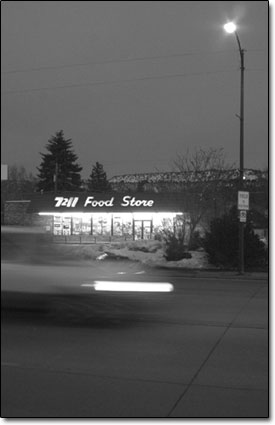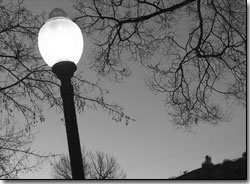|
Local businesses argue that coming into compliance
would create undue burden
by Missy Votel
 |
| A car passes a convenience
store on North Main Avenue at dusk. A city ordinance would
require businesses to turn off outdoor lighting after 11 p.m.
or at the close of business, whichever comes later. It also
would require businesses to shield any outdoor lighting so
direct light shines down, not up and out./Photo by Todd Newcomer. |
As Durango’s Dark Skies ordinance heads to City Council
next week, controversy is stirring over whether or not to grandfather
in nonconforming businesses.
As drafted, the ordinance would require nonconforming businesses
to retrofit their lights by either replacing them or shielding
them so the light shines down and not up. The city would allow
a seven-year grace period for businesses to come into compliance.
However, after listening to an hour and a half of testimony April
5, the Durango Planning Commission voted unanimously to strike
a clause in the ordinance that would require nonconforming businesses
to come into compliance within the allotted seven years. On Tuesday,
May 4, the Planning Commission will recommend approval of the
amended code to council.
Planning commissioners decided to do away with the clause that
would have required retrofitting after listening to arguments
from local business owners and interests that such a demand would
exact an undue burden on them.
“It’s an initiative driven by the city and special
interests, and it puts the cost and burden onto businesses,”
said Bobby Lieb, Durango Chamber of Commerce director and executive
director of the La Plata Economic Development Action Partnership,
or LEAD. “I’d like to see City Council honor the Planning
Commission’s decison to grandfather in existing businesses.”
According to Tom Cummins, owner of ME&E Engineering, replacing
existing nonconforming fixtures with new ones will come at a great
cost to not only business owners, but the city as well. In turn,
these costs will be borne by residents.
“To try to retrofit can be very expensive,” he said,
using the case of the city’s downtown street lighting as
an example. Citing an estimate received by the city in March from
Holophane, an outdoor lighting company, installing cutoff light
fixtures would cost the city anywhere from $240 to $580 per fixture,
depending on the model. The most expensive model would require
adding one new fixture for every two existing ones at an installation
cost of $1,700 each. There are more than 700 unshielded city streetlights
that would have to be retrofitted under the ordinance.
“By the time you’re done, you’re spending $400,000
to half a million,” said Cummins.
Citing other examples during the Planning Commission meeting,
Cummins said the Exxon gas station at Carbon Junction would spend
$12,000 to $15,000 retrofitting; the First National Bank would
spend close to $35,000; and the cost for retrofitting Miller Middle
School would run about $45,000.
Cummins also called into question whether retrofitting would
even have an effect on light pollution. According to the city
memo from Holophane, limiting direct uplight has not been proven
to significantly decrease sky glow. To the contrary, the company
said some studies have shown that the use of cutoff lights actually
increases sky glow and energy consumption.
Cummins said he reached the same conclusion with an informal
observation of the city’s newly installed compliant fixtures
on the Ninth Street bridge and older, noncompliant ones
 |
| A street lamp shines along the Animas River
Trail. The lamp represents one of many that the city would
have to retrofit or shield in order to comply with the Dark
Skies ordinance./Photo by Todd Newcomer. |
“I went up on Cemetery Road and looked down at one of those
lights on the Ninth Street bridge and one of the old, historical
fixtures, and you can’t really tell the difference,”
he said. “Basically, we need to ask is it worth the investment
of half a million dollars plus additional energy costs to have
a marginal effect on the dark skies.”
Nevertheless, Lieb and Cummins said they were not against the
Dark Skies ordinance per se, but would like to see a more equitable
solution for businesses.
“I’m all for moving toward better and more efficient
lighting,” said Lieb.
Both men said they would like to see the city approve an ordinance
that grandfathered in existing businesses and did away with the
retrofitting clause. Rather, they would like to see a gradual
phase-in of compliance whereby new businesses or those undergoing
a remodel would have to comply. In addition, any old, broken 4
fixtures would have to be replaced by new, conforming ones. Cummins
said the standard lifespan of a light fixture is about 30 years,
and many of the city’s street lights are probably approaching
that limit.
“It makes perfect sense,” he said of the phase-in
plan. “When there is a change in ownership or renovation,
the businesses will have to comply, so it’s not like they
won’t ever have to comply.”
Despite being outnumbered at the Planning Commission meeting,
a few residents did speak in favor of keeping the Dark Skies ordinance
as is.
Michelle Reott, principle/manager of Earthly Ideas LLC, a Durango-based
construction and design firm, has been following the Dark Skies
ordinance since the city held its first public informational meeting
on the topic in November of 2001.
“I think it’s something the city should do,”
she said, referring to the requirement that businesses come into
compliance within seven years.
Reott also said while the cost of replacing entire lighting systems
is expensive, many nonconforming lights can be retrofitted with
a shield for less money.
“There is shielding that can be done for most existing
fixtures,” she said. “Cost varies on the type and
how it is attached, but it’s going to be much less expensive
than replacing the fixture.”
She also said that in assessing the Dark Skies ordinance, there
are other considerations beyond financial ones.
“There are social and environmental costs that need to
be considered,” she said. “Light pollution is really
a symptom of waste, so we’re paying a price for it in resource
depletion and impacts associated with generating electricity.”
Millissa Berry, a member of the city planning department who
drafted the Dark Skies ordinance, said that although it could
be argued that adding extra poles would increase energy consumption,
it is not the city or La Plata Electric Association’s intent
to add more poles. She also said that although adding shields
directs more light downward, thus theoretically producing more
light bounce upward when it hits the ground, the problem can be
remedied by using lower wattage bulbs.
“What you do is decrease the bulb size and it actually
could increase energy efficiency,” she said.
Berry pointed out that in her two years working on the Dark Skies
ordinance, she has seen studies that have gone both ways, and
it is up to the city to sift through the information and decide
what works best and makes the most sense.
“You can set up experiments to show it both ways,”
she said.
As per the cost of coming into compliance, Berry said most businesses
should be able to retrofit.
“You don’t have to rip out the whole lighting system,”
she said. Although she did not have any concrete numbers for the
cost of shielding a light, she said it would come in below $100
per light. She also pointed out that businesses would have seven
years to do so.
“For the most part it shouldn’t be that difficult
to retrofit,” she said.
However, she added that the intent of the ordinance is not to
cause hardship for businesses, but to reduce nighttime glare by
directing light downward instead of up.
“The city’s intent is to light the surface and not
the sky,” she said. “We do not see it as a burden
when the whole community has to comply, including the city.”
While numerous positions on the Dark Skies ordinance exist, City
Planner Greg Hoch said in a nutshell, the issue boils down to
abatement – that is whether the city wants to keep the status
quo of the night skies or try to lessen the amount of light pollution.
“It all comes down to deciding between not making the town
any brighter or making it less bright,” he said.
The Durango City Council will consider the Dark Skies ordinance
during its meeting Tuesday, May 4, beginning at 7:30 p.m. in council
chambers.
|

